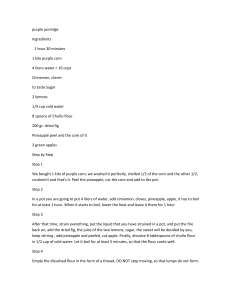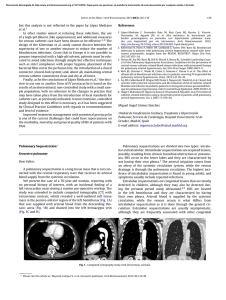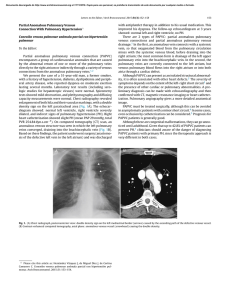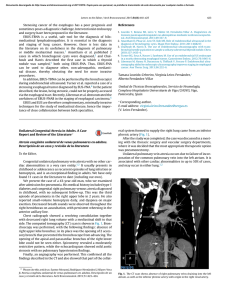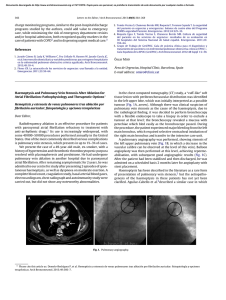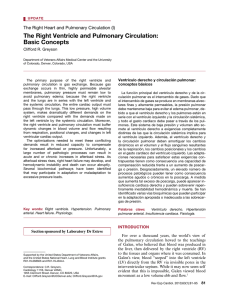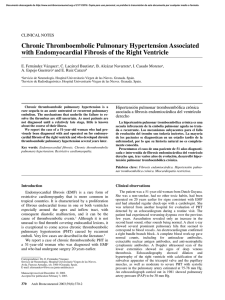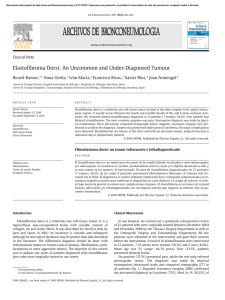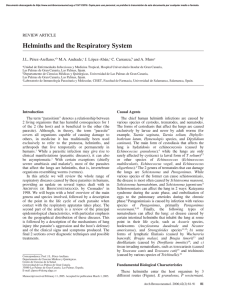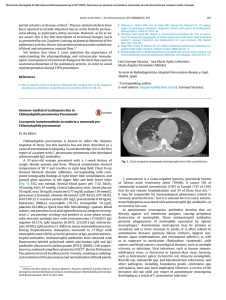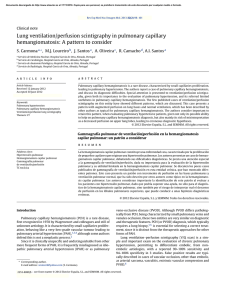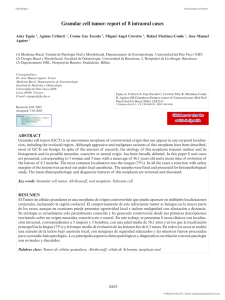are those described above, and it is identical to pleural fibrous tumor
Anuncio
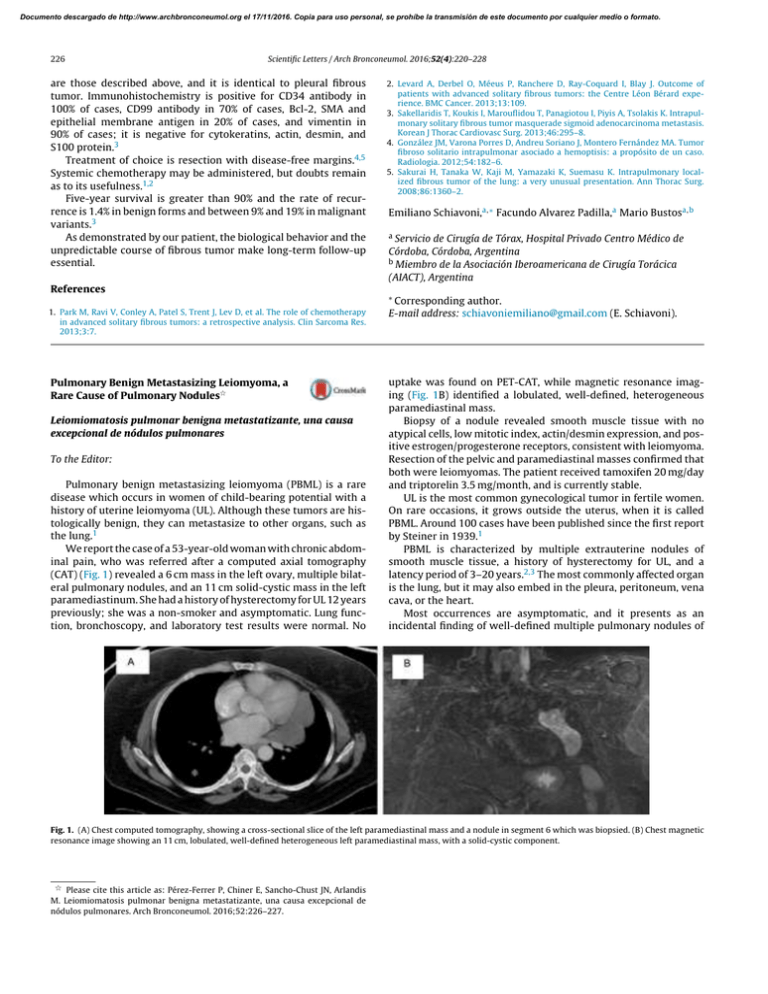
Documento descargado de http://www.archbronconeumol.org el 17/11/2016. Copia para uso personal, se prohíbe la transmisión de este documento por cualquier medio o formato. 226 Scientific Letters / Arch Bronconeumol. 2016;52(4):220–228 are those described above, and it is identical to pleural fibrous tumor. Immunohistochemistry is positive for CD34 antibody in 100% of cases, CD99 antibody in 70% of cases, Bcl-2, SMA and epithelial membrane antigen in 20% of cases, and vimentin in 90% of cases; it is negative for cytokeratins, actin, desmin, and S100 protein.3 Treatment of choice is resection with disease-free margins.4,5 Systemic chemotherapy may be administered, but doubts remain as to its usefulness.1,2 Five-year survival is greater than 90% and the rate of recurrence is 1.4% in benign forms and between 9% and 19% in malignant variants.3 As demonstrated by our patient, the biological behavior and the unpredictable course of fibrous tumor make long-term follow-up essential. 2. Levard A, Derbel O, Méeus P, Ranchere D, Ray-Coquard I, Blay J. Outcome of patients with advanced solitary fibrous tumors: the Centre Léon Bérard experience. BMC Cancer. 2013;13:109. 3. Sakellaridis T, Koukis I, Marouflidou T, Panagiotou I, Piyis A, Tsolakis K. Intrapulmonary solitary fibrous tumor masquerade sigmoid adenocarcinoma metastasis. Korean J Thorac Cardiovasc Surg. 2013;46:295–8. 4. González JM, Varona Porres D, Andreu Soriano J, Montero Fernández MA. Tumor fibroso solitario intrapulmonar asociado a hemoptisis: a propósito de un caso. Radiologia. 2012;54:182–6. 5. Sakurai H, Tanaka W, Kaji M, Yamazaki K, Suemasu K. Intrapulmonary localized fibrous tumor of the lung: a very unusual presentation. Ann Thorac Surg. 2008;86:1360–2. Emiliano Schiavoni,a,∗ Facundo Alvarez Padilla,a Mario Bustosa,b a Servicio de Cirugía de Tórax, Hospital Privado Centro Médico de Córdoba, Córdoba, Argentina b Miembro de la Asociación Iberoamericana de Cirugía Torácica (AIACT), Argentina References 1. Park M, Ravi V, Conley A, Patel S, Trent J, Lev D, et al. The role of chemotherapy in advanced solitary fibrous tumors: a retrospective analysis. Clin Sarcoma Res. 2013;3:7. Pulmonary Benign Metastasizing Leiomyoma, a Rare Cause of Pulmonary Nodules夽 Leiomiomatosis pulmonar benigna metastatizante, una causa excepcional de nódulos pulmonares To the Editor: Pulmonary benign metastasizing leiomyoma (PBML) is a rare disease which occurs in women of child-bearing potential with a history of uterine leiomyoma (UL). Although these tumors are histologically benign, they can metastasize to other organs, such as the lung.1 We report the case of a 53-year-old woman with chronic abdominal pain, who was referred after a computed axial tomography (CAT) (Fig. 1) revealed a 6 cm mass in the left ovary, multiple bilateral pulmonary nodules, and an 11 cm solid-cystic mass in the left paramediastinum. She had a history of hysterectomy for UL 12 years previously; she was a non-smoker and asymptomatic. Lung function, bronchoscopy, and laboratory test results were normal. No ∗ Corresponding author. E-mail address: schiavoniemiliano@gmail.com (E. Schiavoni). uptake was found on PET-CAT, while magnetic resonance imaging (Fig. 1B) identified a lobulated, well-defined, heterogeneous paramediastinal mass. Biopsy of a nodule revealed smooth muscle tissue with no atypical cells, low mitotic index, actin/desmin expression, and positive estrogen/progesterone receptors, consistent with leiomyoma. Resection of the pelvic and paramediastinal masses confirmed that both were leiomyomas. The patient received tamoxifen 20 mg/day and triptorelin 3.5 mg/month, and is currently stable. UL is the most common gynecological tumor in fertile women. On rare occasions, it grows outside the uterus, when it is called PBML. Around 100 cases have been published since the first report by Steiner in 1939.1 PBML is characterized by multiple extrauterine nodules of smooth muscle tissue, a history of hysterectomy for UL, and a latency period of 3–20 years.2,3 The most commonly affected organ is the lung, but it may also embed in the pleura, peritoneum, vena cava, or the heart. Most occurrences are asymptomatic, and it presents as an incidental finding of well-defined multiple pulmonary nodules of Fig. 1. (A) Chest computed tomography, showing a cross-sectional slice of the left paramediastinal mass and a nodule in segment 6 which was biopsied. (B) Chest magnetic resonance image showing an 11 cm, lobulated, well-defined heterogeneous left paramediastinal mass, with a solid-cystic component. 夽 Please cite this article as: Pérez-Ferrer P, Chiner E, Sancho-Chust JN, Arlandis M. Leiomiomatosis pulmonar benigna metastatizante, una causa excepcional de nódulos pulmonares. Arch Bronconeumol. 2016;52:226–227. Documento descargado de http://www.archbronconeumol.org el 17/11/2016. Copia para uso personal, se prohíbe la transmisión de este documento por cualquier medio o formato. Scientific Letters / Arch Bronconeumol. 2016;52(4):220–228 varying sizes,2 70% bilateral, and 17% unilateral. It presents only exceptionally as a solitary nodule.3 More uncommon are the miliary pattern, or cystic or cavitated lesions. Histological features include actin and desmin expression, positive estrogen and progesterone receptors, and benignity, a low mitotic index, no atypical cells, and no tumor necrosis.3 It is produced by independent multifocal proliferations of smooth muscle which respond to hormonal stimulus, or by hematogenous dissemination of an initial UL.3,4 Cytogenetic studies suggest a monoclonal origin. Its course is generally indolent, except when the site, size or number of lesions cause complications.5 The therapeutic approach to PBML is conservative or surgical, and primary excision is the intervention of choice, whenever possible.4 In our case, the paramediastinal mass was resected after it increased in size, to avoid local complications due to compression of the adjacent mediastinal structures, and to confirm the nature of this large cystic lesion that differed greatly from the other nodules. Resection of these lesions is recommended, in order to avoid complications, such as massive hemoptysis, and to rule out lowgrade leiomyosarcoma. Hormone treatment is recommended for inoperable lesions.4 To conclude, PBML should be taken into consideration in women of child-bearing age with multiple pulmonary nodules and history of UL. Rhinoconjunctivitis and Occupational Asthma in a Furniture Factory Worker夽 Rinoconjuntivitis y asma ocupacional en una trabajadora de una fábrica de muebles To the Editor, All workers exposed to cereal flours (not only bakers), may develop sensitization and occupational rhinoconjunctivitis and/or asthma in response to cereal flour allergens.1,2 227 References 1. Steiner PE. Metastasizing fibroleiomyoma of the uterus: report of a case and review of the literature. Am J Pathol. 1939;15:89–110.7. 2. Taftaf R, Starnes S, Wang J, Shipley R, Namad T, Khaled R, et al. Benign metastasizing leiomyoma: a rare type of lung metastases—two case reports and review of the literature. Case Rep Oncol Med. 2014;2014:842801. 3. Fan D, Yi X. Pulmonary benign metastasizing leiomyoma: a case report. Int J Clin Exp Pathol. 2014;7:7072–5. 4. Goto T, Maeshima A, Akanabe K, Hamaguchi R, Wakami M, Oyamada Y, et al. Benign metastasizing leiomyoma of the lung. Ann Thorac Cardiovasc Surg. 2012;18:121–4. 5. Ma H, Cao J. Benign pulmonary metastasizing leiomyoma of the uterus: a case report. Oncol Lett. 2015;9:1347–50. Patricia Pérez-Ferrer, Eusebi Chiner,∗ José Norberto Sancho-Chust, Mar Arlandis Servicio de Neumología, Hospital Universitario San Juan de Alicante, San Juan de Alicante, Alicante, Spain ∗ Corresponding author. E-mail address: echinervives@gmail.com (E. Chiner). We report the case of a 31-year-old woman, employee in a furniture factory for nine years, with a history of mild allergic rhinoconjunctivitis and asthma due to house dust mites. She reported a 3-year history of work-related rhinoconjunctivitis. Two years before referral to our clinic she began to have dry cough and breathlessness, which she also attributed to her work environment. All these symptoms increased minutes after handling rye flour, a component of the wood glue used for building furniture. Skin prick tests (SPT) were positive for grass and olive pollens, Dermatophagoides pteronyssinus, wheat flour and rye flour. SPT using a specially prepared extract of wheat flour and rye flour (10%, %fall in FEV1 Bronchial challenge with rye flour 10 0 -10 -20 -30 -40 -50 -60 -70 -80 Basal 2 min 5 min 10 min 15 min 30 min 60 min 90 min 120 min 180 min Rye flour 0 -42 -70 -56 -54 -46 -16 -0.9 5 6 Saline 0 -4.1 -8 -6 -4.4 -7.4 -5.6 -3.8 5.6 5.9 Fig. 1. Bronchial provocation test with rye flour. 夽 Please cite this article as: Gómez-Torrijos E, Núñez M, Rodríguez RG. Rinoconjuntivitis y asma ocupacional en una trabajadora de una fábrica de muebles. Arch Bronconeumol. 2016;52:227–228.
